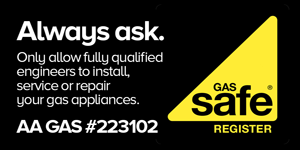Popular UK boiler manufacturer Vaillant sells a variety of different combi, system and heat-only boiler models.
Each of these appliances comes with built-in error codes (also known as fault codes).
The purpose of these codes is to alert you to specific issues. Some side effects include ruining your day and a steady flow of colourful language when you’ve deciphered the codes.
By following your Vaillant boiler’s instructions, you’ll be left with a clear idea of what the fault means or at least what it might indicate (as sometimes error codes can have several meanings).
Moreover, these instructions will provide you with a list of potential solutions, some of which may be DIY-friendly. Naturally, this is contingent on how DIY-friendly you are (or your spouse is).
However, in general, most error code solutions require the help of a registered Gas Safe engineer.
With all that said, while you should primarily rely on your boiler’s instructions, the following guide will give you a clear overview of the most notable error code features with Vaillant boilers.
Without further ado, let’s dive in!
Rather than provide a list of every single error code associated with the Vaillant boiler ranges, for simplicity, we’ll be focusing on the most common error/fault codes from the brand.
You will notice that some of the boiler ranges have matching error codes.
You may also notice that different error codes can have the same meaning. Reading a Vaillant error code can at times be as clear as trying to find out what’s happening with your teenage child.
In this particular section, we’ll look at Vaillant’s combi boilers.
The most common error codes of Vaillant system boilers and heat-only boilers can be found in the next sections.
| Fault Code | Description |
|---|---|
| F.10 Short circuit: flow sensor | Flow temperature sensor is experiencing a defect or a short-circuit |
| F.13 Short circuit: Cylinder sensor | Warm start sensor/cylinder temperature sensor is either not connecting or defective |
| F.23 Safety switch-off: Temp. spread too large | Temperature spread is too great and the water circulation is low |
| F.22 Safety switch-off: Low water pressure | Water pressure is too low or there is either an insufficient quantity of water in the product or none at all |
| F.24 Safety switch-off: Temp. increase too fast | The temperature has increased too quickly |
| F.25 Safety switch-off: Flue temp too high | The flue gas temperature is too high |
| F.32 Fault: Fan | Fan isn’t connected or is experiencing a defect |
| F.64 Fault: Electronics/sensor | There is a defect with the electronics, safety-relevant sensor or cable |
| F.67 Fault: Electronics/flame | Flame signal is implausible |
| F.73 Fault: Water pres. sensor (signal too weak) | Water pressure sensor is showing that the water pressure inside your boiler is too low |
| F.74 Fault: Water pres. sensor (signal too strong) | Water pressure is too high |
| F.84 Fault: NTCs temp. difference implausible | Temperature difference isn’t plausible |
| Communication fault: | There is a communication fault occurring between your boiler’s PCB (inside the electronics box) and the display. |



| Fault Code | Description |
|---|---|
| F.10 Short circuit: flow sensor | Flow temperature sensor is experiencing a defect or a short-circuit |
| F.13 Short circuit: Cylinder sensor | Warm start sensor/cylinder temperature sensor is either not connecting or defective |
| F.22 Safety switch-off: Low water pressure | Water pressure is too low or there is either an insufficient quantity of water in the product or none at all |
| F.23 Safety switch-off: Temp. spread too large | Temperature spread is too great and the water circulation is low |
| F.24 Safety switch-off: Temp. increase too fast | The temperature has increased too quickly |
| F.25 Safety switch-off: Flue temp too high | The flue gas temperature is too high |
| F.32 Fault: Fan | Fan isn’t connected or is experiencing a defect |
| F.64 Fault: Electronics/sensor | There is a defect with the electronics, safety-relevant sensor or cable |
| F.67 Fault: Electronics/flame | Flame signal is implausible |
| F.73 Fault: Water pres. sensor (signal too weak) | Water pressure sensor is showing that the water pressure inside your boiler is too low |
| F.74 Fault: Water pres. sensor (signal too strong) | Water pressure is too high |
| F.84 Fault: NTCs temp. difference implausible | Temperature difference isn’t plausible |
| Communication fault: | There is a communication fault occurring between your boiler’s PCB (inside the electronics box) and the display. |
| Fault Code | Description |
|---|---|
| F.10 | Flow temperature sensor fault - Short circuit |
| F.22 | Safety switch-off because the water pressure inside the boiler is too low. |
| F.28 | Boiler ignition fault, unsuccessful ignition when starting up. |
| F.29 | Flame loss fault |
| F.49 | eBus fault - voltage is too low |
| F.65 | Electronics temperature is too high (fault) |
| F.71 | Fault with the flow/return temperature sensor |
| F.87 | Fault with electrodes |
| F.88 | Fault with the gas valve |
| F.89 | Fault with the pump |
| Communication | Your boiler’s PCB and user interface are not communicating |
| Fault Code | Description |
|---|---|
| F.10 | Flow temperature sensor fault - Short circuit |
| F.11 | Return sensor has short circuited |
| F.22 | Safety switch-off because the water pressure inside the boiler is too low. |
| F.32 | Faulty fan | F.64 | Electronics/sensor fault |
| F.68 | Fault - the flame signal is unstable |
| F.73 | Water pressure sensor fault |
| F.74 | Water pressure sensor fault |
| F.90 | Communication fault |
Moving on to Vaillant’s system boiler ranges, again, we will not list every single fault code but highlight some of the most common ones.
Again, you may notice that some of Vaillant’s system boiler ranges have matching error codes.
For Vaillant’s heat-only boiler fault codes, skip to the section below.
| Fault Code | Description |
|---|---|
| F.10 | Flow temperature sensor fault - Short circuit |
| F.22 | Safety switch-off because the water pressure inside the boiler is too low. |
| F.28 | Boiler ignition fault, unsuccessful ignition when starting up. |
| F.29 | Flame loss fault | F.49 | eBus fault - voltage is too low |
| F.65 | Electronics temperature is too high (fault) |
| F.71 | Fault with the flow/return temperature sensor |
| F.87 | Fault with electrodes |
| F.88 | Fault with the gas valve |
| F.89 | Fault with the pump |
| Communication | Your boiler’s PCB and user interface are not communicating |
| Fault Code | Description |
|---|---|
| F.10 Short circuit: flow sensor | Flow temperature sensor is experiencing a defect or a short-circuit |
| F.13 Short circuit: Cylinder sensor | Warm start sensor/cylinder temperature sensor is either not connecting or defective |
| F.22 Safety switch-off: Low water pressure | Water pressure is too low or there is either an insufficient quantity of water in the product or none at all |
| F.23 Safety switch-off: Temp. spread too large | Temperature spread is too great and the water circulation is low | F.24 Safety switch-off: Temp. increase too fast | The temperature has increased too quickly |
| F.68 | Fault - the flame signal is unstable |
| F.25 Safety switch-off: Flue temp too high | The flue gas temperature is too high |
| F.32 Fault: Fan | Fan isn’t connected or is experiencing a defect |
| F.64 Fault: Electronics/sensor | There is a defect with the electronics, safety-relevant sensor or cable |
| F.67 Fault: Electronics/flame | Flame signal is implausible |
| F.73 Fault: Water pres. sensor (signal too weak) | Water pressure sensor is showing that the water pressure inside your boiler is too low |
| F.74 Fault: Water pres. sensor (signal too strong) | Water pressure is too high |
| F.84 Fault: NTCs temp. difference implausible | Temperature difference isn’t plausible |
| Communication fault: | There is a communication fault occurring between your boiler’s PCB (inside the electronics box) and the display. |


